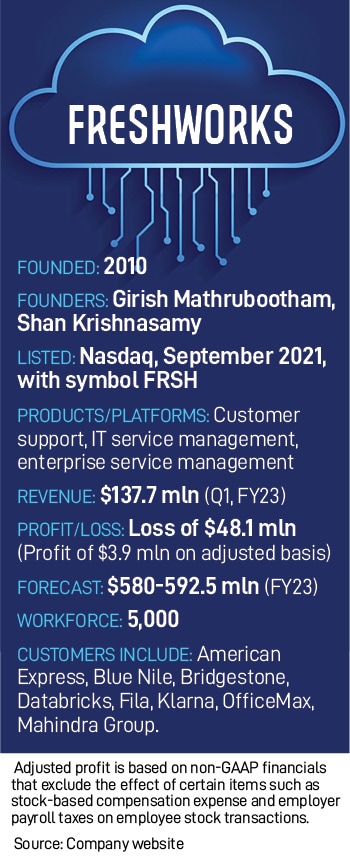
How Freshworks wants to tap Generative AI and go after larger customers
Harnessing technologies like GPT and Copilot, the Nasdaq-listed software company plans to ramp up its own growth
 Girish Mathrubootham, CEO and Founder, Freshworks
Image: Courtesy Freshworks
Girish Mathrubootham, CEO and Founder, Freshworks
Image: Courtesy Freshworks
It was a slightly overcast morning in Bengaluru, with intermittent drizzling, as many software developers, almost all of them in their 20s, walked into a building named Aquila – from the Latin word for eagle, and a constellation in the northern hemisphere – to attend a Freshworks conference, recently. The monsoons were still playing hide and seek with India.
Taking the lift several floors up, they entered a large hall, big enough for an Indian wedding reception, on loan to Freshworks for the event from one of Amazon’s development centres, the main occupant of the building, located in one of many in the tech parks on Bengaluru’s outer ring road.
Neighbouring buildings included Orion, Taurus and Carina, and some of the neighbours were Samsung, Qualcomm, Google, and Red Hat. Inside the hall, there was everything from south Indian breakfast to espresso shots for the bleary-eyed night-owl coders on offer who might have crawled away from their screens to attend the event. As part of the opening session of the event, Freshworks’s Founder and CEO Girish Mathrubootham appeared onscreen, with a short, prepared message.
The audio was slightly out of sync with the visual, but the message was simple, and to the point. Freshworks wants to make life easy, and even fun, for developers to build great apps for its ecosystem. Software companies typically offer such apps on their marketplaces for customers to directly download and start using.




 This effort to engage more deeply with developers is one of many initiatives at Freshworks to go after the larger customers (often called enterprise customers, as against SMB customers for small and medium sized businesses) whose orders can help the company grow faster, and even become profitable. But such customers also demand more robustness and depth than the SMB segment that Freshworks grew up serving.
This effort to engage more deeply with developers is one of many initiatives at Freshworks to go after the larger customers (often called enterprise customers, as against SMB customers for small and medium sized businesses) whose orders can help the company grow faster, and even become profitable. But such customers also demand more robustness and depth than the SMB segment that Freshworks grew up serving.




